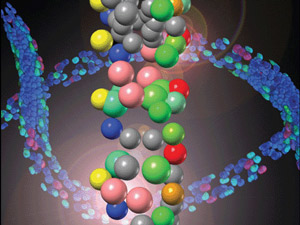
2012 Therapeutics Conference: a retrospective
HDBuzz looks back at the 2012 Huntington's Disease Therapeutics Conference

In this special report, we review the 2012 Annual Huntington’s Disease Therapeutics Conference, the year’s biggest gathering of HD drug hunters. We left impressed with a few big themes. The rapid advancement of drugs designed for HD – the emergence of a “systems biology” approach to considering the disease in its entirety – and the increasing understanding that’s emerging to help us design and run trials to have big impact on HD.
The mountainous desert of Palm Springs provided a dramatic backdrop to the 2012 Huntington’s Disease Therapeutics Conference. Hosted by CHDI, the largest funder and driver of HD research globally, the Conference hosts many of the world’s top HD researchers, bringing them together to discuss the latest research and form valuable collaborations to share their expertise.
Systems Biology

Image credit: Nature Publishing Group
The Conference began with an unusual theme: a focus on Systems Biology. That’s an abstract term for the simple idea that nothing in biology happens in isolation. As many people who have cared for an HD patient know, every symptom affects every other symptom, in complex and unpredictable ways. Systems Biology is the application of this idea that everything is connected, to our studies of HD – from molecules and cells to communities.
Computers and technology can now help scientists to study many more things than the human brain can consider at once. As a practical example, it’s becoming as easy to sequence someone’s entire genome as it is to test or measure changes in one gene. Generating vast amounts of data is increasingly easy – what’s difficult is turning this data into useful information. How do we use all the information we can collect to better understand HD? Or – how do we turn ideas into wisdom?
This is what Systems Biology is all about – and CHDI has jumped into the field in a big way. They’ve hired a new Vice President, Keith Elliston, whose job it is to encourage the Systems Biology approach to make the most of the work of HD scientists. HDBuzz snagged an interview with Elliston – look out for it in a future article.
CHDI has even given its logo a facelift to mark the occasion. Simon Noble revealed the new logo – a tree made from interconnected circles, reflecting CHDI’s view that atoms, genes, cells and people are fundamentally linked in the quest for effective treatments for HD.
The Systems Biology approach was outlined in a series of talks begun by Lee Hood, (Institute for Systems Biology, Seattle). Hood has spent decades applying technology to human disease, and his organization has recently gotten interested in HD in a big way. As an example of the type of work that’s now possible, Hood’s team is sequencing the entire genomes of multiple HD families – looking for very rare DNA changes that affect what age HD symptoms begin. The idea is if we can understand why some people have late or early onset, we could identify new targets for developing drugs.
Building on this theme, Jim Gusella reflected on his work to identify genes that affect the progression of HD. Gusella’s team recently pooled and reanalyzed loads of data using modern statistical techniques to re-evaluate whether previously reported ‘genetic modifiers’ stood up to scrutiny. Gusella plans to apply analysis methods using the interconnectedness of genes, to get the most out of large genetic studies that are underway.
Hanchuan Peng (Howard Hughes Medical Institute) demonstrated one impressive example of how Systems Biology can enhance our understanding. Using cutting-edge technology, he’s produced incredibly detailed 3D maps of worms called C. elegans that are commonly used in genetic research. These kind of maps will help us move to a level where diseases or treatments can be examined in terms of how they affect whole networks of cells.
Gene silencing
Gene silencing is a simple idea with a lot of promise as a treatment for Huntington’s disease. Gene silencing drugs – with names like RNAi and ASO – are tailor-made to stick to the message molecule that’s produced from the HD gene. Once the drug sticks to the message molecule, production of the mutant protein is reduced. The hope is that this will allow HD-affected neurons to recover.
So far, all the evidence from animal trials points to gene silencing drugs being effective, and safe enough to move forward to human clinical trials. Now, at least four teams are planning trials to test different gene silencing drugs in HD patients. Therapeutics Conferences have discussed gene silencing before, but this was different – here, the talk was about the practicalities of getting the drugs to human trials quickly and safely, and anticipating and avoiding possible pitfalls.
Frank Bennett spoke on behalf of Isis Pharmaceuticals, a company that specializes in gene silencing drugs called ASOs. An ASO is a DNA-like molecule with one strand rather than two. ASOs spread through the brain quite well, so Isis is planning to inject the drug into the fluid at the base of the spine. That may sound gruesome, but remember that the alternative is injecting drugs into the brain. Bennett reported that Isis has now given gene silencing ASO drugs to over 2,000 patients with various diseases – a track record that offers some reassurance.
Bennett discussed the development of Isis’ gene silencing ASO drug for Huntington’s disease. A trial of infusing the ASO drug into the spinal fluid of monkeys showed that it reached various brain regions, especially the cortex (that’s the crinkly surface of the brain). The deep substance of the brain that’s affected early in HD – the striatum – received a smaller dose of drug, but only human trials will tell us whether it’s enough to make a difference. Thankfully, the drug was well tolerated and didn’t cause any obvious harm – a crucial step on the way to trials in patients.
Isis’ current focus is on drugs that silence both copies of the HD gene that we all have. That’s easier to do, and easier to test, so it makes sense to start with that approach. But Isis is also working on drugs that target just the mutant gene, leaving the ‘normal’ copy untouched. They’ve bred special HD mice to help them test these ‘allele-specific’ silencing drugs.
Neil Aronin of the University of Massachusetts gave an enlightening update on some of the challenges he’s working to overcome in the area of gene silencing drugs. Aronin is particularly keen on allele-specific drugs that target only the mutant gene. Like other groups working on gene silencing, Aronin’s team has begun to focus on the practicalities of running human trials. He’s enlisted a neurosurgeon colleague to try something new and unusual – performing brain surgery on a sheep. Sheep have brains nearly as big as human brains, so they are ideal for refining the scanning and surgery techniques that will be needed to deliver gene silencing drugs to patients.
“A new era is beginning, with a number of therapies poised to be tested in patients that have been tailor-made for HD”
Aronin’s also thinking carefully about minimizing possible side effects of gene silencing drugs. Using giant Lego pieces, he demonstrated how the drug molecule might be broken down into smaller bits, each of which might still be able to bind to a message molecule – possibly switching off other genes we’d rather not touch. Improving our knowledge of how cells break down gene silencing drugs will help us to design drugs that minimize these ‘off target’ effects.
Some of the most advanced results so far in HD gene silencing were recently published by the three-way team of medical technology company Medtronic, RNAi drug maker Alnylam and researchers at the University of Kentucky. Medtronic’s Bill Kaemmerer reported that a clinical trial of their drug and delivery method in patients is already in the advanced planning stage.
Kaemmerer discussed the challenge of figuring out whether the drug has worked in patients – not a straightforward matter because HD causes changes slowly, over years. If we’re lucky, we’ll see improvements on clinical measurements. But that’s not guaranteed, even if the drug works. So we need a backup plan.
Measurements of brain biomarkers might help – chemicals released when neurons are malfunctioning or dying. If the treatment alters levels of these biomarker chemicals, it might give a clue to whether the drug is working. Medtronic is proposing to use several possible biomarkers to help run their trials.
Steve Zhang (Sangamo BioSciences) spoke about a ‘next generation’ approach to gene silencing using zinc finger drugs. These are designer drugs that can attach directly to chosen sequences in our DNA. Zinc finger drugs could directly prevent the HD gene from being read, or even – far in the future – carry out ‘genome editing’ to snip out the bad gene altogether. These techniques are a long way off yet, but it’s great to know that these exciting technologies are being applied to HD so that hopefully we’ll see a continuous improvement in our ability to target the disease.
Next-door neighbors
Everyone has high hopes for gene silencing, but we have to be careful not to put all our eggs in one basket. Gene silencing drugs alone might not be enough to halt HD completely, and most researchers reckon that several treatments, targeting different aspects of HD, may be necessary. So the session on ‘upstream’ and ‘downstream’ targets was important.
By this, we mean the ‘next door neighbors’ just before and after the huntingtin protein is made. The first step to making a protein is creating an RNA ‘message molecule’, using the HD gene as a template. This RNA manufacture process is the ‘upstream’ neighbor. The neighbor on the ‘downstream’ side is what happens after the protein is made: chemical tags are added that alter how the protein is handled in cells. That process is called post-translation modification.
Why focus on these next-door neighbors? They’re close to the mutant protein itself, so small changes to these processes might be able to make a big difference to the many bad effects of the protein.
Melissa Moore (University of Massachusetts) explained how it might be possible to exploit cells’ RNA manufacturing machinery to treat HD. Drugs that target RNA directly can’t be taken in pill form and require surgery to get them into the brain. The advantage of targeting the RNA-making machines, rather than the RNA itself, is that ‘small molecule’ drugs might work – the kind of chemical that could be taken as a pill.
In practice, we may end up targeting both the RNA message and the RNA-making machinery. For instance, a protein called SPT4 was recently found to be involved in reading long CAG repeats in our DNA. An SPT4-targeting drug might be able to enhance the action of a gene silencing drug, to help it target the mutant copy of the gene. Drugs that work on cells’ RNA-making machinery are already being tested in diseases like cystic fibrosis and similar approaches are now being studied in HD.
Naoko Tanese (New York University) discussed an intriguing new role for the huntingtin protein. Huntingtin has lots of functions, and new ones are being discovered all the time. Tanese’s team found that huntingtin hangs around with several RNA message molecules, raising the possibility that one job of huntingtin might be ‘shuttling’ RNA round cells. Adding another layer of intrigue, it seems that huntingtin might even shuttle its own RNA message molecule. Understanding the basic functions of huntingtin is important as we approach the stage of altering the production and function of huntingtin in patients.
Turning to the ‘downstream’ next-door neighbor, Lisa Ellerby reviewed the array of ‘tags’ that can be added to various parts of the huntingtin protein. Different molecular machines called enzymes add and remove each tag, depending on the situation the cell finds itself in.
How do we know which tags, and which enzymes, are most important? Marcy MacDonald of Massachusetts General Hospital proposed that we might be able to exploit the unusual nature of the HD mutation to help us decide. We know that the mutant huntingtin protein gets more toxic if it contains more glutamine building blocks – each one corresponding to one ‘CAG’ in the HD gene. MacDonald has produced huntingtin proteins containing different amounts of glutamine. The modifications that are found in the longer proteins might be the most important to focus on.

Dimitri Krainc (also of Massachusetts General Hospital) gave an update on one type of post-translational modification, called acetylation. Sticking an ‘acetyl’ tag onto the huntingtin protein tells cells to get rid of it by dissolving it. An enzyme called HDAC4 removes the acetyl tags, so we’d expect that reducing HDAC4 activity would be good. When Krainc’s team bred cells without HDAC4, they found suggestions that huntingtin removal was increased.
One HDAC enzyme, sirtuin-1, is the focus of a current drug trial in HD. Selisistat – a drug that decreases the activity of sirtuin-1 – is being tested in Europe in a trial called PADDINGTON. Krainc’s team have found that the drug does act on sirtuin-1 to increase acetyl-tagging, as expected. The published results of the first phase of the trial will hopefully tell us more.
Small is beautiful
Drug hunters are a bit obsessed with small molecules. Big or complex chemicals tend not to make for good drugs, because they are usually unstable, and have difficulty getting into the brain. So, the ideal drug is a small molecule that hits a chosen target. Drug developers do lots of chemical tweaking, to maximize desirable properties, and reduce side-effects.
One target where drug development has advanced significantly in the past year is phosphodiesterase (PDE) inhibition. CHDI’s Vahri Beaumont and Pfizer’s Chris Schmidt jointly presented the results of their collaboration. Last year we heard about synapses – the chemical connections that transmit signals between neurons – and the PDE enzymes that break down the signaling molecules on the far side of the synapses. We know that synaptic function goes wrong in HD, and that this seems linked to the functioning of PDE enzymes. Because connections are all-important in the brain, it’s hoped that restoring synaptic function might improve HD symptoms – and if we’re lucky, it might also slow down the degenerative process.
There are lots of PDE enzymes, and careful study has identified PDE9 and PDE10 as the ones that are most involved in HD, and the most likely to be possible targets for drugs. Through studying living slices of HD mouse brain, we can identify abnormal electrical behavior. Beaumont reported that using drugs to inhibit PDE 9 and 10 restored favorable electrical properties in these brain slices. Tantalizingly, this included improvements in the longer term functions thought to underlie learning and memory.
Schmidt announced Pfizer’s carefully thought-out plan for progressing PDE inhibitors to human trials. PDE10, the more promising target, is the priority candidate. First, Pfizer will conduct animal studies looking at the drug’s safety and effectiveness. We can’t slice people’s brains up and stick electrodes in, so we’ll need biomarkers to give an early idea of whether the drug’s doing what we want. This is the same principle we mentioned earlier for gene silencing trials. For Pfizer, this means developing new brain imaging techniques to look at the functioning of synapses in humans.
Pfizer’s timeline for its PDE10 inhibitor includes studies in humans in late 2012 and a larger 6-month trial planned in 2013-14. “This is not about rushing headlong into a trial … but a clinical experiment,” said Schmidt, “so succeed or fail, we’ll learn a lot’.
KMO inhibitors were one of the big HD therapeutics stories of 2011. KMO is an enzyme that alters the balance between a chemical that protects neurons – Kyna – and another that harms them – Quin. A drug developed by Paul Muchowski’s group, JM6, was reported to reduce the activity of KMO and enabled HD mice to live longer. Ladislav Mrzljak unveiled CHDI’s top KMO inhibitor candidate – CHDI-246. This designer drug has favorable properties and so far appears to produce healthy changes in brain chemistry, and seems safe. Interestingly – like JM6 – CHDI-246 doesn’t actually enter the brain. Instead, it appears to produce positive effects by inhibiting KMO in blood cells. This is a new and ground-breaking approach to brain drug development – but if it works, it’s likely to catch on.
CHDI is now pressing on with tests of CHDI-246 in three different rodent HD models. That’s more rigorous than many drugs go through, but we reckon it’s crucial to test drugs in this way, to make sure only the best ones get through to expensive and time-consuming human trials.
Another drug giant, Novartis, has just completed a human trial in HD. Graham Bilbe described how their drug, Mavoglurant, blocks glutamate receptors in the brain and is intended as a treatment for HD symptoms – especially unwanted movements. The results of the trial should be announced soon. One important lesson here is how long it takes to turn an idea into a drug – the idea of blocking glutamate receptors began decades ago and, after years of intensive work, is only now being tested in patients.
Getting it right first time
With all these drugs poised to be tested, it’s crucial that the next generation of human trials for HD is smart and efficient. Testing drugs is incredibly expensive, so it’s essential to get it right first time. Thankfully this has been an area of HD research where real progress has been made, and we reckon we’re now ready to test the drugs waiting in the wings.
Spearheading CHDI’s clinical trial efforts is Christina Sampaio. As the former head of the European Medicines agency, Sampaio brings a wealth of expertise in testing drugs and getting them approved – and her powers are now focused, laser-like, on Huntington’s disease! Sampaio, who is not shy of expressing controversial opinions, asserted that we have to move on from approaches that have failed to deliver in the past. We need to run smart trials, instead of big or long trials, she suggested.

Sampaio also reflected that new treatments would likely be tested first in people with symptoms of HD, where it’s possible to judge success. Treatments that work will then be tested to see if they can prevent symptoms from developing. She echoed the earlier idea that multiple treatments with different effects may be needed to tackle HD.
Marking the end of one era, and the beginning of a new one, Sarah Tabrizi (University College London) announced the final 3-year data from the international TRACK-HD study. TRACK-HD aimed to identify the best combination of measurements for testing drugs in different stages of HD – the biomarkers we mentioned earlier. Tabrizi demonstrated how the TRACK-HD toolkit could be used to decide how many people would be needed for a trial of any drug, and what biomarkers would be best at testing it.
TRACK-HD identified brain changes long before the official diagnosis of symptoms in HD. That may sound worrying, but it can also be seen as a good thing, because it suggests that the brain is actually really good at compensating for damage. As Tabrizi put it, “there’s a lot that we may be able to rescue”.
With this in mind, Tabrizi announced a new study, TrackOn-HD, aimed at probing these functional changes in the HD brain before signs of the disease emerge, to help us understand how the brain compensates and hopefully give us biomarkers for trials in ‘pre-manifest’ HD.
Big-picture thinking
Talk of ‘onset’ of HD symptoms set the scene for Mark Guttman (Centre for Movement Disorders, Ontario) to open a debate on how Huntington’s disease is defined. Is HD present from birth, does it begin when a neurologist diagnoses it, or is there a ‘spectrum’ of symptoms that comes on gradually over many years? This is an important topic, because a diagnosis of ‘onset’ is commonly used to inform important decisions like work and family planning – and also controls entry to clinical trials, and approval of new drugs.
The area is probably less controversial than you might think from the strong opinions that are often heard. Both patients and doctors are aware of ‘soft’ changes that precede an ‘official’ diagnosis of HD. So perhaps all that’s needed is to agree on better language for describing them. A discussion with the global community, aimed at figuring out this area, has begun.
With his closing talk, Michael Hayden (University of British Columbia) looked far ahead. Recent figures have suggested that HD may be twice as common as previously thought. Combine this with an aging population and the end product, claims Hayden, is that HD will become a relatively common disease with the majority of cases occurring in the elderly – something health care planners will need to think about. Meanwhile, Hayden’s studies of sperm samples to figure out how often CAG counts increase or decrease are likely to improve the reliability of genetic counseling for people at risk of HD.
A new era
We had high hopes for the 2012 Therapeutics Conference, and weren’t disappointed. A new era is beginning in Huntington’s disease drug development, with a number of therapies poised to be tested in patients that have been tailor-made for HD, using knowledge painstakingly gained since the HD mutation was discovered nearly twenty years ago. This puts us in a very different place from where we were as recently as five years ago.
Not only do we have the drugs to test – and more in the pipeline – but we have a clear idea of how to test them, too, thanks to studies like TRACK-HD. Forthcoming clinical trials should be well-run, smart and efficient. There is no guarantee that any experimental treatment will work, but we can be confident that the trials, and the drugs they’re testing, will be as good as possible.
In terms of specifics, keep your ears and eyes open for news of PDE-inhibitor drugs and gene silencing trials over the coming months and years. Wherever you’re reading this article is where you’ll be able find out the latest in the world of HD therapies research.
Learn more
Sources & References
For more information about our disclosure policy see our FAQ…


